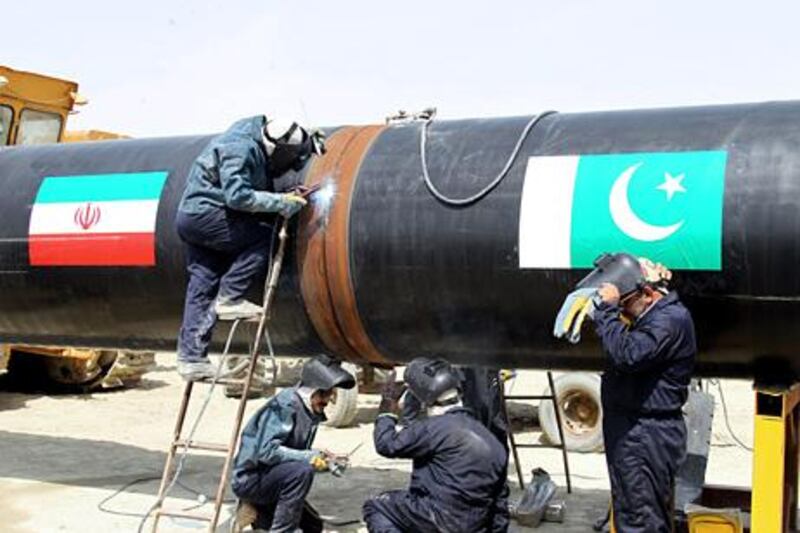The great British historian AJP Taylor dismissed contemptuously what he called "cigar-butt strategy". This was his term for a First World War politician pointing at a map with his cigar and saying, "Let's go here", ignorant of the local terrain or population. When it comes to playing grand geopolitics with oil and gas pipelines, cigar-butt strategy is still with us.
Making headlines last week were claims that Saudi Arabia had offered Russia incentives to drop its support for Syria's president Bashar Al Assad - including preventing Arabian Gulf gas from competing with that of Russia in Europe.
This contrasts with theories that the Syrian conflict is somehow linked to attempts by Iran to build a pipeline through Iraq and Syria to Europe. Never mind that Russia does not want to encourage competition from Iranian gas, nor that war-torn Iraq and Syria are hardly promising places for multibillion-dollar investments in vulnerable pipes, nor that Europe would first have to lift sanctions.
A little thought shows that Syria is a dead-end for gas - Iran exports to Europe would go through Turkey, to whom it already has a pipeline connection.
In June, another pipeline, Nabucco, bit the dust as Azerbaijan selected the less evocative and ambitious Tap (Trans Adriatic Pipeline), backed by the German utility giant E.ON Ruhrgas, to carry its gas to Europe. Russia has attempted to maintain its grip on Europe by promoting South Stream under the Black Sea, at the impressive cost of US$17 billion.
Similar phantom pipelines exist as dotted lines on maps of Asia. Two favourites are an oil and gas line from Pakistan's port of Gwadar, up through Afghanistan to China, and a line known as Tapi (Turkmenistan-Afghanistan-Pakistan-India) in the opposite direction from Turkmenistan's giant fields to Pakistan and India.
The US government has enthusiastically promoted Tapi since the 1990s. It ticks several geopolitical boxes - it would reduce Central Asian countries' dependence on Russia and China, bring revenues to stabilise Afghanistan after the withdrawal of US troops, and persuade Pakistan and India not to buy Iranian gas. But Tapi also faces major challenges at beginning, middle and end. Turkmenistan has not decided whether it really wants to supply the pipeline, Afghanistan poses challenges of terrain and security, and India is worried about depending on Pakistan for transit. A more realistic option might emerge if domestic finds in Afghanistan could be the first stage of supply to Pakistan.
The Gwadar pipeline is less feasible - running from a barren outpost, through unsettled Baluchistan and Afghanistan, ascending some of the world's highest mountains, over an immense distance to impoverished western China.
What are some of the immutable laws of pipelines we can derive from these illustrations? One is that pipelines are expensive and vulnerable. Seaborne transport of oil is always preferable, where possible.
Pipelines require the politics to be right - many economically-attractive routes have been blocked by indigenous peoples, separatists, environmental groups or unfriendly transit states. As Egypt's cancellation of gas supplies to Israel, or the failure of routes to India via Pakistan show, pipelines do not bring peace; they follow it.
But the same is true in reverse - political alignment is not enough. There also has to be a commercial logic.
Construction requires the backing of a financially- and technically-strong oil company, whether a Russian or Chinese state entity, or an international company such as BP or E.ON. Sometimes the motives are less obvious - Russia supports South Stream as a way of avoiding what it sees as the troublesome transit state Ukraine, but also as a source of kickbacks on overpriced contracts to insiders.
Whether pointing at maps with cigar or shisha pipe, though, the most important lessons are not to ignore realities on the ground, nor to neglect pipeline practicalities in search of grand Eurasian geopolitics.
Robin Mills is the head of consulting at Manaar Energy, and the author of The Myth of the Oil Crisis and Capturing Carbon
Cigar-butt strategy lives on in effort to realise pipe dreams
The great British historian AJP Taylor dismissed contemptuously what he called "cigar-butt strategy".

More from the national




